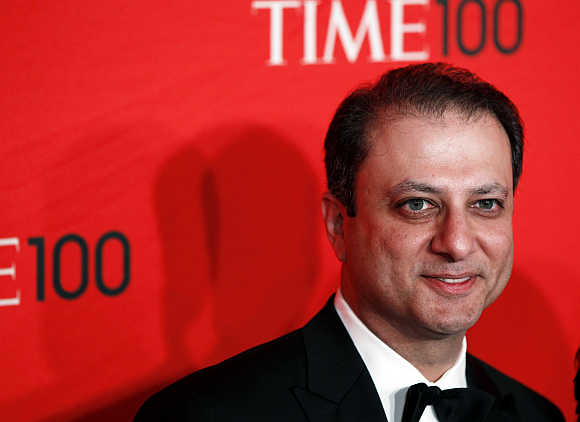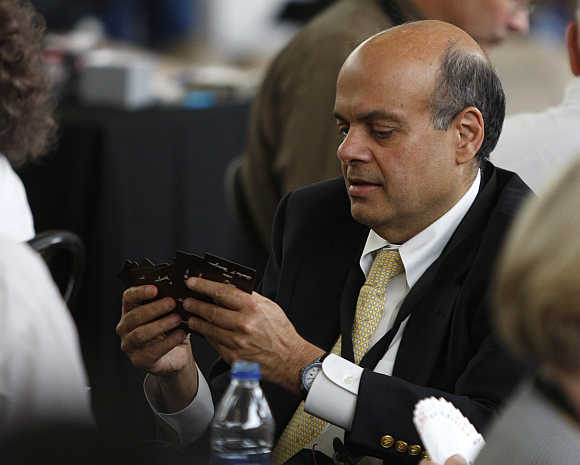
It would be natural to expect that a book sub-titled The Rise of The Indian-American Elite would focus on the success of Indian immigrants in the United States. Instead, The Billionaire’s Apprentice dwells for the most part on the fall from grace of two uber-successful South Asians, a hedge-fund tycoon and the eminence grise of corporate America.
And it paints a tangled but mostly unflattering picture of their Indian-American friends, family and colleagues, many of whom were also involved in what the government has claimed was illegal information sharing and trading. Anita Raghavan’s well-researched book paints a fascinating word portrait of the life stories of Raj Rajaratnam and Rajat Gupta, and how they reached the pinnacle of success on Wall Street and corporate America before being accused and eventually convicted for insider trading.
One of the most engrossing threads in the book is how it traces the origins of the downfall of the two titans to a routine report by the Swiss bank UBS. In 2006, almost four years before the grand finale, UBS volunteered information to the government about cherry-picking violations at a small-time hedge fund called Sedna, run by a heady 35-year-old money manager named Rajarengan ‘Rengan’ Rajaratnam.

The tale’s origins can be traced to the momentous month of September 2008 that saw the demise of Lehman Brothers, and eventually led to the global financial crisis which almost put the world economy into a depression. Even mighty Goldman Sachs, the bluest of blue chip investment banks, was looking to Warren Buffett for a lifeline after being buffeted by the chaos in financial markets. Goldman was keen to have the Sage of Omaha, whose right-hand man happened to also be an Indian American named Ajit Jain, give a vote of confidence by committing a significant amount of capital to the firm.
The book masterfully portrays the drama of how the Apprentice makes a fateful call to the Billionaire at 3.54pm Eastern time (1.24am India time), a minute after hanging up on a critical board meeting call when Buffett’s investment became known to members, and six minutes before the market close. The order to ‘buy Goldman Sachs’ was barked out with urgency on the trading desk at 3.56:44pm Eastern time (1.26:44am India time). A similar sequence of events transpired October 23 following a Goldman Sachs Board meeting where members were told that the firm was going to post an unprecedented loss. Cue a call 23 seconds later to the Billionaire, who not only sold the stock but told an associate that he had inside information from someone on the Goldman Sachs board.
In the end, the book brings it all together with a sensitive and human portrayal of events at court, pitting former friends, colleagues and partners against each other, and former close family friends watching as two of the most powerful men in the US undergo a devastating public trial ending in conviction. Raghavan does not give any benefit of doubt to Rajat’s version of the story that these calls were unrelated to insider information and were not atypical for an extremely busy executive used to catching up on pending items and returning calls between meetings.
And the book concludes with a dramatic but unnecessary - and arguably cruel - flourish in tying the storyline back to a family secret going back to the 1930s.
Raghavan states in the acknowledgements section that her agent realised early on that “…the Galleon case was the perfect way to tell the story that I had been wrestling with for years: the rise and maturation of the South Asian diaspora in the United States.”
...

Later, she adds: “…I had been struggling to find an engaging way to write about the South Asian diaspora in the United States. The Galleon arrests provided the perfect vehicle… it was a tale of the early migration of Indians to the United States, their breathtakingly swift rise and heady success in America, and last but most important, the emergence of a second generation of Indians who would ignore the blind loyalties their fathers held to kin and country and serve as a model of assimilated Indians in America.”
Readers may judge for themselves if the Galleon story and the downfall of Raj and Rajat are the best way to tell the story of the rise and maturation of the South Asian Diaspora, and whether and how ignoring ‘blind loyalties’ to kin and country leads to becoming a model of assimilation. The book puts a harsh spotlight on 12 Indian Americans and two Sri Lankans out of a total of 130-plus people charged with insider trading by the Securities and Exchange Commission over the past two-three years.
That’s just about 10 per cent of those charged, which is not too far out of proportion from the percentage of Indian Americans in senior positions on Wall Street and in Silicon Valley. In other words, the Indian-American community is no better or worse than most other nationalities in having its share of transgressors.
Meanwhile, as the book itself points out, 70 per cent of Indian Americans have bachelor’s degrees compared to a national average of 28 per cent, and a median annual household income that is twice the national average and 33 per cent higher than Asian Americans in general. The book also mentions but pays little attention to dozens of Indian Americans who lead respectable and law-abiding lives and have succeeded in reaching the highest leadership positions in academia and industry as members of a model immigrant community.
Many of the Indian Americans that Raj Rajaratnam interacts with regularly for philanthropic and business reasons are the who’s who of corporate America, and their ability to succeed without breaking the law is never a focus of this book. Even more interestingly, two of the most powerful ‘good guys’ on the government side, who pursued and prosecuted the Galleon case, were Indian Americans.
Preet Bharara, the US attorney for the Southern District of New York, occupies an office that was graced by none other than former New York mayor Rudy Giuliani. Rajat Gupta gets three times the number of mentions in the book as compared to Bharara.
...

Likewise, Sanjay Wadhwa, assistant regional director of the New York office of the SEC and deputy chief of the Market Abuse Unit, has a lead role in the Galleon saga. If Raj and Rajat played leading roles in the fall of the Galleon hedge fund, then Preet and Sanjay were the good guys who showed that many members of the South Asian community were also leading the charge for truth, justice and the (Indian-)American way.
Raghavan often generalises and conflates the actions and behaviour of a few individuals that she may have come across or met with the Indian-American community at large. To say that a “…new wave of Indians, stepping off of Boeing 747s in the 1980s… considered themselves superior” because they had a “…sense of belonging and an identity” hits too close to home.
I am one of those who attended college and stayed in the same dormitory in India as one of the book’s protagonists, stepped off a Boeing 747 in the 1980s, and eventually went to Wharton just a few years after Raj Rajaratnam. The references to a ‘wide social chasm’ at Wharton between Indians from India and Indian Americans have no foundation in the reality that I experienced.
As for the insider trading case itself, SAC, managed by the iconic hedge-fund manager Steve Cohen, paid more than $600 million to the government, compared to $156 million in combined criminal and civil penalties paid by Raj Rajaratnam and the $100 million paid by Ivan Boesky in the 1980s trading scandals. Clearly, Indian Americans are not the only ones being convicted for insider trading nor are they the best at it; or worst, depending on your perspective!
The book is a must-read as a sad but gripping story of the downfall of a man about whom the presiding judge said: “The court can say without exaggeration that it has never encountered a defendant whose prior history suggests such an extraordinary devotion, not only to humanity writ large, but also to individual human beings in their times of need.”
Yet, it also will feel like a case of schadenfreude in seeing the mighty fail and fall, with a title like The Billionaire’s Apprentice and weighty phrases like ‘Twice Blessed’ to parallel the ‘Twice Born’ name for the Brahmin caste (Dvija).
One can only wish Raghavan had chosen to shine a spotlight on the law-abiding role models and success stories of Indian Americans whose names are sprinkled throughout the book, rather than just focusing on the Billionaire and the putative Apprentice.
Ram Kelkar lives in Chicago.